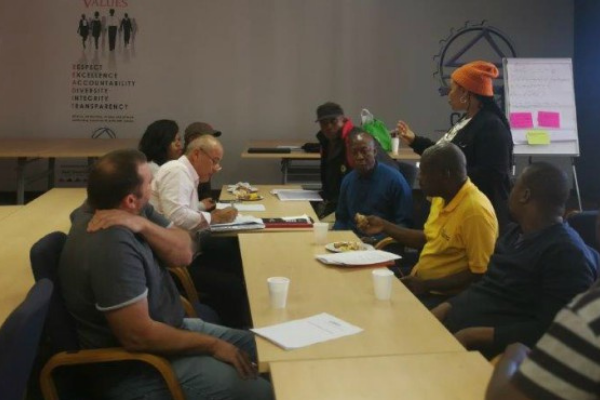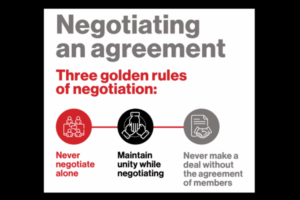In a tense room, three groups of union negotiators were set for a mock bargaining session, facing off against mock bosses. The atmosphere was charged as they prepared to simulate a real-world negotiation.
“It doesn’t matter which side of the table you’re on; what counts is that you play your part well,” advised George Mthethwa, an LRS Educator who led an LRS Collective Bargaining Forum in Johannesburg in May 2018. The forum brought together a diverse mix of participants, including domestic workers, public servants, and plant-level negotiators.
“Play your role according to your contractual or social obligations. Imagine you have an economic stake in it,” added forum co-facilitator Nosipho Twala.
George and Nosipho use simulated learning to teach negotiation and bargaining concepts to trade union members. They find it effective because it engages participants in deep learning, fostering a better understanding. Continuous learning is crucial for union negotiators, especially in South Africa, where collective bargaining faces many challenges. Issues like informalisation, new technology, globalisation, and the expansion of multinational companies add layers of complexity to the process.
The forum on May 4th was one of many that the LRS hosts annually to help union negotiators refine their strategies. This session aimed to give participants, including trade union organisers and shop stewards, a better understanding of collective bargaining across various industries. It was the first time domestic workers were included in a mainstream negotiation workshop, making it a unique experience. Participants discussed how the market economy affects collective bargaining and reflected on what they might be doing right in these processes.
Mimicking a bargaining process
The mock bargaining exercise mirrored real negotiations, complete with substantive union demands and often belligerent mock bosses. The demands ranged from wage increases and allowances to maternity leave and shift allowances.
Participants acting as bosses displayed typical tactics: arrogance, disinterest, and dismissiveness. They withheld profit and revenue information, skirting transparency and unions’ rights to relevant data. On the other side, union representatives often showed unpreparedness, lacking in-depth knowledge of the companies’ financials and the current inflation rate, which is an important factor in wage negotiations.
Key observations
Prioritising demands: Unions often fail to prioritise their demands effectively, sometimes relying too heavily on a single spokesperson rather than a panel. This makes it easier for bosses to isolate and pressure the union representative.
Strategy and tactics: When negotiations become tense, unions may disrupt the meeting or quickly revise their offers without thorough consideration. This can weaken their bargaining position.
Legal and legislative context: Some demands are already covered by legislation, but the strained relationship between labour and the state complicates enforcement.
Vulnerable sectors: Domestic workers, despite legal protections, often face intimidation and barriers to unionisation, especially when bargaining occurs in private homes.
Plant-level negotiations: These are ideal as shop stewards are familiar with the company’s history and financial situation.
Lessons learned
Skills development: Negotiators need strong communication, problem-solving, and analytical skills. Understanding both technical and emotional factors is crucial.
Team presentation: Introducing everyone on the negotiating team establishes credibility and showcases diverse expertise.
Preparation and strategy: Thorough preparation, including understanding the company’s financials and having a clear set of prioritised demands, is vital. Unions should avoid revealing their fallback positions too early.
Community engagement: Keeping the community informed during strikes helps build support and sympathy, highlighting the broader social and economic issues at play.
Continuous improvement: Unions must adapt and innovate, moving beyond traditional militant approaches. Learning business language and strategies can help them better engage with employers.
"Don't focus solely on inflation when bargaining. For better results, consider other benchmarks, prioritise key issues, and stick to your timelines."
George Mthethwa, LRS Educator
Some remarks from the floor
"I'm sad to see what this beautiful process has become."
"I'm shocked by how unprepared we often are. We need to reflect on this with our teams."
"I'm angry at the arrogance of employers."
"I'm humbled by how hard we try to get the best deal for our members, even under such harsh circumstances."







